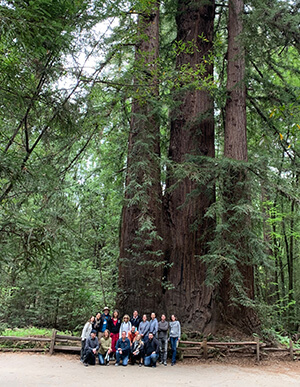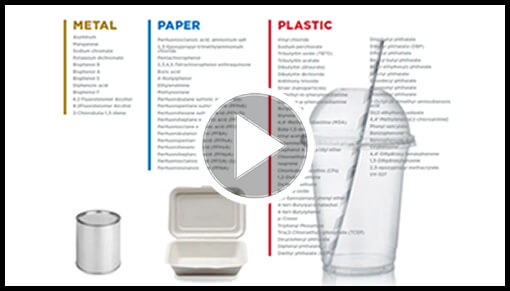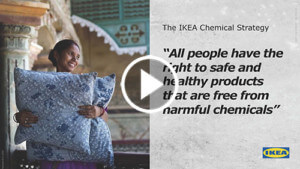May 2020: From the Forest to the Zoom
In this edition:
- Retreat Day 1: Antimicrobials in the Time of Coronavirus
- Retreat Day 2: Petrol, Plastic, Poisons
- Retreat Day 3: PFAS and the Class Concept
- Chemicals, Children, and Celiac
- Toxics in Tap Water: Problematic for Water Reuse?
- CALENDAR
As we continue with shelter in place, we do hope you are keeping well. This month we held our eighth annual Six Classes Toxics Reduction Retreat. For seven years, decision makers from business, government, academia, and the nonprofit sector came together in idyllic outdoor locales, such as the Santa Cruz mountains, to develop creative ideas to reduce the use of chemicals classes of concern.
Due to the coronavirus pandemic, this year we decided to move our retreat online and were unsure about whether new relationships would be made and new ideas developed. However, despite trading our verdant forest venue for Zoom, our first virtual retreat was a big success.
Over three days, thirty-six participants enjoyed online lectures, discussions, strategy sessions–and dance parties. We focused on antimicrobials in the time of coronavirus; the connections between plastic, climate change, and toxics; and managing PFAS as a class. We developed high-impact ideas and have already created follow-up groups to take action. For example, one group developed an antimicrobials messaging brief that participant and retired NIEHS Director Linda Birnbaum sent to her longtime colleague NIAID Director Anthony Fauci to include in his communications with the public.
I am relieved and very happy that our virtual retreat turned out so well, as our workshops and gatherings may need to be online for some time to come. You can watch videos of retreat presentations here and brief summaries of outcomes and next steps are below.
One recurring theme of our virtual retreat was that the chemical industry is trying to capitalize on the coronavirus. TIME magazine recently reported that the petrochemical industry is working to overturn or delay bans on single-use plastic bags, claiming they’re the “most sanitary choice.” This flies in the face of evidence that the coronavirus can live on plastic surfaces up to three days and does not survive as well on soft surfaces, like fabric. And these efforts are beginning to succeed-here in Berkeley we cannot bring reusable bags into grocery stores.
This February a horrifying 343 new plastic production plants and expansions were permitted or planned in the US. The good news is that many are now cancelled or put on hold due to the virus, fall in the price of oil, and plastic bag bans–which are having a big impact worldwide.
As the pandemic continues, scientists are learning more about how this virus spreads and how we can best stay safe. This viral blog post from a U. Mass Dartmouth Professor explains how breathing, singing, and talking spreads virus particles in common indoor spaces. His post concludes that the risk of infection is low outdoors. This week, the Washington Post published an article about reducing your personal risk, which stated that “…there are no documented cases of someone acquiring covid-19 by passing a stranger while walking outdoors.” I so appreciate this as I very much enjoy my daily walks in the Berkeley hills.
Finally, you may remember that our last newsletter highlighted our peer-reviewed study on PFAS in nursery school carpets.
I hope you can enjoy outdoor time and vacation this summer.
Warm regards,
Arlene and the Green Science Policy team
Retreat Day 1: Antimicrobials in the Time of Coronavirus
Ted Schettler, Science Director, Science and Environmental Health Network
Antimicrobials in the Time of Coronavirus
Anne-Cooper Doherty, Senior Env. Scientist, DTSC Safer Consumer Products Program
Introduction to Quaternary Ammonium Compounds
Rolf Halden, Professor, Arizona State U.
Selecting Safe Antimicrobials to Combat COVID-19
Antimicrobials do not generally provide an increased benefit against the coronavirus compared to soap and water and other safer alternatives. Nonetheless, potentially harmful cleaning and disinfectant products are now in high demand and being marketed for a surprising variety of uses–without a demonstrated benefit.
This session explored the problems associated with the inappropriate use of antimicrobials and began to point to solutions. For example, the increasingly widespread use of quaternary ammonium compounds (QACs or quats)–associated with a wide range of adverse health effects–is of concern. Some of the most effective disinfectants, based on alcohol, citric acid, lactic acid, or hydrogen peroxide, are EPA-approved and less hazardous.
A follow-up group is developing messaging on safe and effective handwashing techniques and cleaning protocols. A second working group composed of retailers and manufacturers is sharing best practices and developing strategies for purchasing and manufacturing safer products without the unnecessary use of harmful chemicals.
After you view the talks, please get in touch if you might like to be informed of the outcomes from these two working groups or might be interested in joining one if space permits.
Retreat Day 2: Petrol, Plastic, Poisons
Marty Mulvihill, Partner, Safer Made and co-founder, Berkeley Center for Green Chemistry
Petroleum, Plastic, and Poisons
Dianna Cohen, CEO & Co-Founder, Plastic Pollution Coalition
The Global Plastic Pollution Crisis
Ken Alex, Director, Project Climate, UC Berkeley
The Plastics-Climate Connection
This session explored the links between fossil fuels, plastic pollution, and chemicals of concern, such as those in the Six Classes. The demand for fossil fuels is dropping making them less profitable, so the petrochemical industry now views plastics and chemicals as the way to maintain demand for petroleum and natural gas. In 2018, plastics production accounted for half of the global growth in natural gas production, and this share is increasing. The use of toxic chemicals in products and materials is similarly growing.
The three speakers emphasized the importance of understanding the direct connection between fossil fuels, plastics pollution, and exposures to hazardous chemicals, in order to move away from all of these materials at the same time. One possibility was a credit and debit system that would set in place disincentives for petroleum-based products and promote alternatives. A working group will discuss these issues in more depth. We can share outcomes when we have them, if you write us.
Retreat Day 3: PFAS and the Class Concept
Linda Birnbaum, Retired Director, NIEHS and NTP
Challenges of PFAS
Therese Lilliebladh, Product Requirement Manager, Chemicals, IKEA of Sweden
IKEA’s Journey towards Healthier Products utilizing the Class Concept
Bjorn Hansen, Executive Director, European Chemicals Agency (ECHA)
Overview of ECHAs Activities to Group Chemicals and Limit PFAS
The common theme in these three talks is that there are too many PFAS to deal with one-at-a-time. Whether one is making purchasing decisions, assessing toxicity, or managing chemicals in a global supply chains, taking a class-based approach to PFAS is an efficient way of working.
Less than one percent of all PFAS have been tested for toxicity, but studied PFAS have been associated with cancer, decreased fertility, immune system harms, adverse developmental effects, and other serious health problems. Additionally, one of the big ideas that resonated with participants is that “persistence is enough” when it comes to evaluating a chemical’s hazard. Due to their chemical structure, all PFAS are either extremely persistent or partially transform into extremely persistent PFAS. Look for more on this from the working group that formed on Day 3.
Chemicals, Children, and Celiac
By Rebecca Fuoco
Might your ability to eat pancakes be affected by the pan you use to make them?
This year’s Celiac Awareness Month saw a groundbreaking study from NYU finding a link between the disease and exposure to pesticides, PFAS, and flame retardants.
Celiac disease is a serious autoimmune disorder triggered by consuming a protein called gluten, which is found in wheat, barley, and rye. Common symptoms include diarrhea, bloating, gas, fatigue, and anemia. It can also lead to other health complications. The only treatment is a strict and lifelong adherence to a gluten-free diet, which can come with practical, social, and economic challenges.
The researchers found that children and young adults with high blood levels of pesticides were twice as likely to be newly diagnosed with celiac disease. Girls with elevated levels of PFAS were five to nine times more likely to have the disease, and boys were twice as likely to be diagnosed with the disease if they had elevated blood levels of PBDEs.
Celiac disease is known to be a genetic disorder, but less is known about environmental exposures that may affect its onset. The NYU study is the first to find a measurable link between diagnosis and chemical exposures.
“These results also raise the question of whether there are potential links between these chemicals and other autoimmune bowel diseases, which all warrant close monitoring and further study,” said the study’s senior investigator and pediatric gastroenterologist Jeremiah Levine.
You can read the full study in Environmental Research.
Toxics in Tap Water: Problematic for Water Reuse?
As climate change and population pressures threaten water supplies, an increasing number of communities are considering potable water reuse (i.e., using highly purified wastewater for drinking).
However, according to a new study published in the Journal of the American Water Works Association, treated wastewater contains unregulated chemical contaminants that could pose health risks if not sufficiently removed. This article warns that chemical policy and research gaps must be closed before widespread adoption of potable water reuse, especially in smaller communities that may not be able to afford adequate water treatment.
PFAS, antimicrobials, and flame retardants are among the contaminants in treated wastewater and this article provides yet another reason why the Six Classes should not be used unless essential.
You can read the article free online through June here.
CALENDAR
October 3 to 4, 2020: 37th Annual Berkeley Himalayan Fair
Please note the new date.
Enjoy the food, music, dance, crafts, and arts of the Himalayas. Profits to Himalayan charities. Where: Live Oak Park, 1300 Shattuck Avenue at Berryman, North Berkeley.
More information at https://himalayanfair.net/
October 28, 2020: CWEA PFAS Summit, Reno, Nevada
Arlene Blum will keynote the PFAS Summit at California Water Environment Association (CWEA) Annual Conference. Her talk is entitled: “PFAS: What It is, What It Comes From, Where It’s Found and Its Dangers”
- When: 10:00am
- Where: Reno-Sparks Convention Center, Reno, NV
Receive Updates By Email
Subscribe to our monthly newsletter and get these updates delivered right to your inbox!






